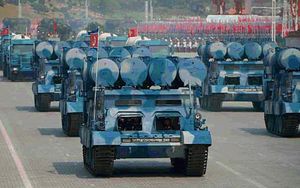Early on Thursday morning, North Korea fired multiple presumed coastal defense cruise missiles from its east coast. The missiles flew for 200 kilometers before splashing down in international waters in the Sea of Japan, according to the South Korean military.
“North Korea fired several unidentified projectiles, assumed to be short-range surface-to-ship cruise missiles, this morning in the direction of the East Sea from the vicinity of Wonsan, Gangwon Province,” South Korea’s Joint Chiefs of Staff (JCS) said, according to Yonhap. “The flight distance is around 200 km.”
Pyongyang will likely release images and video footage of the test, which appears to have been a success, on Friday morning, but from the available data, it is likely that the missiles may have been the new land-based version of North Korea’s Kh-35 (SS-N-25) variant, known by the United States as the KN-01 and by North Korea as the Kumsong-3.
At North Korea’s April 15 parade, we saw a new type of four-canistered transporter-erector-launcher (TEL) in the Korean People’s Navy’s blue camouflage. The canisters appeared similar to North Korea’s ship-based launchers for the KN-01. The new TEL had tank treads, like the Pukkuksong-2 TEL and the TEL for the new Scud with terminal maneuverability tested in the final week of May.
As I explained then, “The tracked TELs are again suggestive of Pyongyang envisioning their use in a versatile ‘shoot-and-scoot’ coastal artillery scenario, where each unit would strike surface combatants at sea and move to avoid retaliation.”
The timing of Thursday’s launch is notable too. North Korea conducted the test as U.S. aircraft carriers began to exit the Sea of Japan after conducting exercises. Additionally, the launch followed the expansion of United Nations Security Council sanctions against Pyongyang in retaliation for its missile tests.
If Thursday’s test did indeed involve the new KN-01 CDCM TEL, North Korea will have shown off its fourth brand new missile system since February. It has so far this year unveiled the Pukkuksong-2 medium-range ballistic missile, the Hwasong-12 intermediate-range ballistic missile, and a new “ultra-precision” Scud.
North Korea additionally tested the Pongae-5 surface-to-air missile system successfully in May, with Kim Jong-un declaring that the system had reached initial operating capability.
In particular, the Pongae-5 combined with the new Kumsong-3 would enable North Korea to implement an anti-access/area denial posture in wartime, denying littoral space to U.S. and South Korean naval assets.
Adequate intelligence, surveillance, and reconnaissance capabilities will remain a challenge for North Korea, which may not have the sophisticated high-resolution radars necessary to detect and strike advanced stealth systems deployed by its adversaries. (ISR challenges are one reason too why North Korea may not be working toward an anti-ship ballistic missile system.)

































